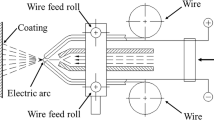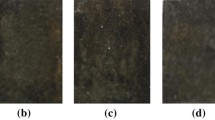Abstract
To make cities more environmentally friendly, combustible wastes tend to be incinerated in waste-to-energy power plant boilers. However, release of chlorine gas (Cl2) during incineration causes serious problems related to hot corrosion of boiler tubes and poses a safety threat for such plants. In this study, a pseudo-de Laval nozzle was employed in a twin-wire arc spray system to enhance the velocity of in-flight particles. Highly dense NiCr-based coatings were obtained using the modified nozzle gun. The coating morphology was characterized by optical microscopy and scanning electron microscopy, and hot corrosion testing was carried out in a synthetic molten chloride salt environment. Results showed that the dense NiCr-based coatings exhibited high resistance against corrosion by chlorine, which can be related to the typical splat lamellar microstructure and chemical composition as well as minor alloying elements such as Ti and Mo.









Similar content being viewed by others
References
R.A. Antunes and M.C.L. de Oliveira, Corrosion in Biomass Combustion: A Materials Selection Analysis and Its Interaction with Corrosion Mechanisms and Mitigation Strategies, Corros. Sci., 2013, 76, p 6-26
M. Bläsing and M. Müller, Release of Alkali Metal, Sulphur, and Chlorine Species from High Temperature Gasification of High- and Low-Rank Coals, Fuel Process. Technol., 2013, 106, p 289-294
K. Persson, M. Broström, J. Carlsson, A. Nordin, and R. Backman, High Temperature Corrosion in a 65 MW Waste to Energy Plant, Fuel Process. Technol., 2007, 88(11-12), p 1178-1182
N. Saqib and M. Bäckström, Trace Element Partitioning in Ashes from Boilers Firing Pure Wood or Mixtures of Solid Waste with Respect to Fuel Composition, Chlorine Content and Temperature, Waste Manag., 2014, 34(12), p 2505-2519
N. Huber, S. Eschlböck-Fuchs, H. Scherndl, A. Freimund, J. Heitz, and J.D. Pedarnig, In-Line Measurements of Chlorine Containing Polymers in an Industrial Waste Sorting Plant by Laser-Induced Breakdown Spectroscopy, Appl. Surf. Sci., 2014, 302, p 280-285
Q. Li, A. Meng, J. Jia, and Y. Zhang, Investigation of Heavy Metal Partitioning Influenced by Flue Gas Moisture and Chlorine Content During Waste Incineration, J. Environ. Sci., 2010, 22(5), p 760-768
E. Mohammadi Zahrani and A.M. Alfantazi, Molten Salt Induced Corrosion of Inconel 625 Superalloy in PbSO4-Pb3O4-PbCl2-Fe2O3-ZnO Environment, Corros. Sci., 2012, 65, p 340-359
T.S. Sidhu, S. Prakash, and R.D. Agrawal, Hot Corrosion Studies of HVOF NiCrBSi and Stellite-6 Coatings on a Ni-Based Superalloy in an Actual Industrial Environment of a Coal Fired Boiler, Surf. Coat. Technol., 2006, 201(3-4), p 1602-1612
R.A. Rapp and Y.-S. Zhang, Hot Corrosion of Materials: Fundamental Studies, JOM, 1994, 46(12), p 47-55
R.A. Rapp, Hot Corrosion of Materials: A Fluxing Mechanism?, Corros. Sci., 2002, 44(2), p 209-221
A. Zahs, M. Spiegel, and H.J. Grabke, Chloridation and Oxidation of Iron, Chromium, Nickel and Their Alloys in Chloridizing and Oxidizing Atmospheres at 400-700 °C, Corros. Sci., 2000, 42(6), p 1093-1122
Y. Kawahara, High Temperature Corrosion Mechanisms and Effect of Alloying Elements for Materials Used in Waste Incineration Environment, Corros. Sci., 2002, 44(2), p 223-245
J. Ma, S.M. Jiang, J. Gong, and C. Sun, Behaviour and Mechanisms of Alkali-Sulphate-Induced Hot Corrosion on Composite Coatings at 900 °C, Corros. Sci., 2012, 58, p 251-259
M.A. Uusitalo, P.M.J. Vuoristo, and T.A. Mäntylä, High Temperature Corrosion of Coatings and Boiler Steels Below Chlorine-Containing Salt Deposits, Corros. Sci., 2004, 46(6), p 1311-1331
L.N. Moskowitz, Application of HVOF Thermal Spraying to Solve Corrosion Problems in the Petroleum Industry—An Industrial Note, J. Therm. Spray Technol., 1993, 2(1), p 21-29
H.J. Grabke, E. Reese, and M. Spiegel, The Effects of Chlorides, Hydrogen Chloride, and Sulfur Dioxide in the Oxidation of Steels Below Deposits, Corros. Sci., 1995, 37(7), p 1023-1043
E. Mohammadi Zahrani and A.M. Alfantazi, Hot Corrosion of Inconel 625 Overlay Weld Cladding in Smelting Off-Gas Environment, Metall. Mater. Trans. A, 2013, 44(10), p 4671-4699
S. Liu, Z. Liu, Y. Wang, and J. Tang, A Comparative Study on the High Temperature Corrosion of TP347H Stainless Steel, C22 Alloy and Laser-Cladding C22 Coating in Molten Chloride Salts, Corros. Sci., 2014, 83, p 396-408
M. Oksa, J. Metsäjoki, and J. Kärki, Thermal Spray Coatings for High-Temperature Corrosion Protection in Biomass Co-Fired Boilers, J. Therm. Spray Technol., 2015, 24(1), p 194-205
M. Oksa, P. Auerkari, J. Salonen, and T. Varis, Nickel-Based HVOF Coatings Promoting High Temperature Corrosion Resistance of Biomass-Fired Power Plant Boilers, Fuel Process. Technol., 2014, 125, p 236-245
S. Matthews and M. Schweizer, High-Temperature Oxidation and Smelt Deposit Corrosion of Ni-Cr-Ti Arc-Sprayed Coatings, J. Therm. Spray Technol., 2013, 22(6), p 932-946
E. Qin, Q. Huang, Y. Shao, G. Chen, L. Ye, Q. Gu, and S. Wu, The Characterization of Twin-Wire Arc-Sprayed FeCrBSi Coating and the Application in Sewage Sludge Boilers, J. Therm. Spray Technol., 2014, 23(8), p 1493-1498
P. Niranatlumpong and H. Koiprasert, Phase Transformation of NiCrBSi-WC and NiBSi-WC Arc Sprayed Coatings, Surf. Coat. Technol., 2011, 206(2-3), p 440-445
M.P. Planche, H. Liao, and C. Coddet, Relationships Between In-Flight Particle Characteristics and Coating Microstructure with a Twin Wire Arc Spray Process and Different Working Conditions, Surf. Coat. Technol., 2004, 182(2-3), p 215-226
M. Seo, G. Hultquist, C. Leygraf, and N. Sato, The Influence of Minor Alloying Elements (Nb, Ti and Cu) on the Corrosion Resistivity of Ferritic Stainless Steel in Sulfuric Acid Solution, Corros. Sci., 1986, 26(11), p 949-960
J.H. Potgieter and K. Varga, The Influence of Various Major and Minor Alloying Elements on the Corrosion of an Fe-40%Cr Superferritic Stainless Steel in Sulphuric Acid, Mater. Corros., 1997, 48, p 221-227
Acknowledgments
The authors gratefully thank Ms. Y. Liu for help with SEM and XRD tests and Mr. C.B. Zou for help with spraying coating samples. The authors are also grateful for fruitful discussions with Dr. R. Balijepalli (Max Plank Institute for Iron Research GmbH) and Prof. D. L. Zhang (Northeastern University China).
Author information
Authors and Affiliations
Corresponding author
Rights and permissions
About this article
Cite this article
Qin, E., Yin, S., Ji, H. et al. Hot Corrosion Behavior of Arc-Sprayed Highly Dense NiCr-Based Coatings in Chloride Salt Deposit. J Therm Spray Tech 26, 787–797 (2017). https://doi.org/10.1007/s11666-017-0549-2
Received:
Revised:
Published:
Issue Date:
DOI: https://doi.org/10.1007/s11666-017-0549-2




